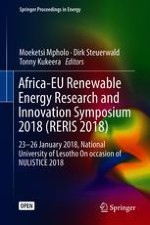8.1 Introduction
8.2 The Challenges and Success Factors of Rural Electrification
8.3 Current Electrification Situation in Lesotho
Project | Bulk power purchased (M) | O&M costs | Electricity sales | Deficit (M) |
|---|---|---|---|---|
Qholaqhoe/Makhunoane | 379,810.27 | 60,000.00 | 186,634.38 | −253,175.89 |
Dilli-Dilli/Sinxondo | 236,361.50 | 63,600.00 | 215,412.83 | −84,548.67 |
Mpiti-Sekake | 1,032,085.06 | 96,360.00 | 877,422.90 | −251,002.16 |
Total | 1,648,256.83 | 219,960.00 | 1,279,490.11 | −588,726.72 |
